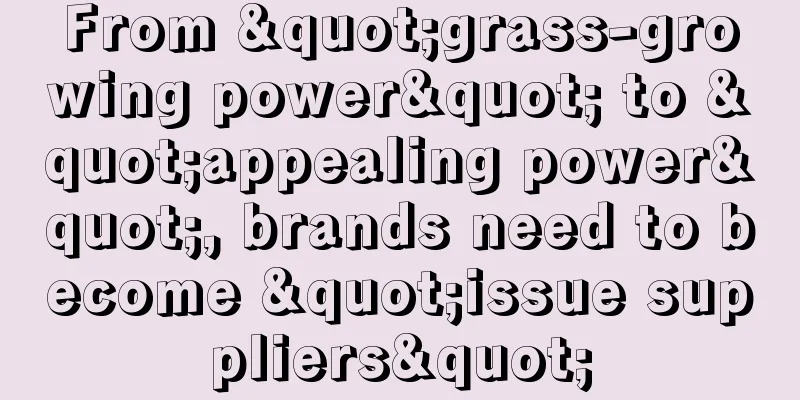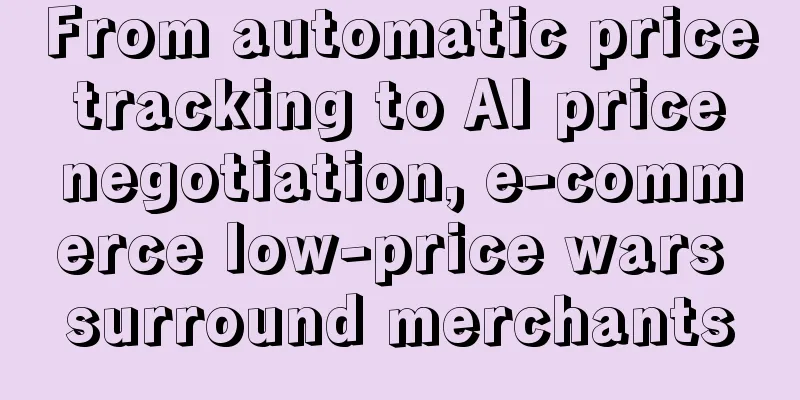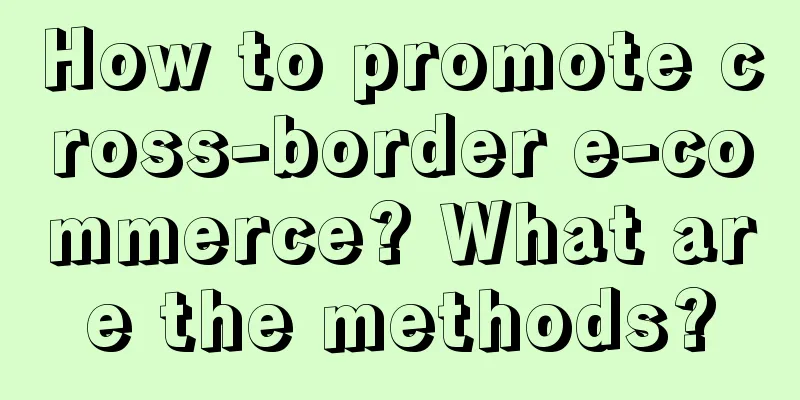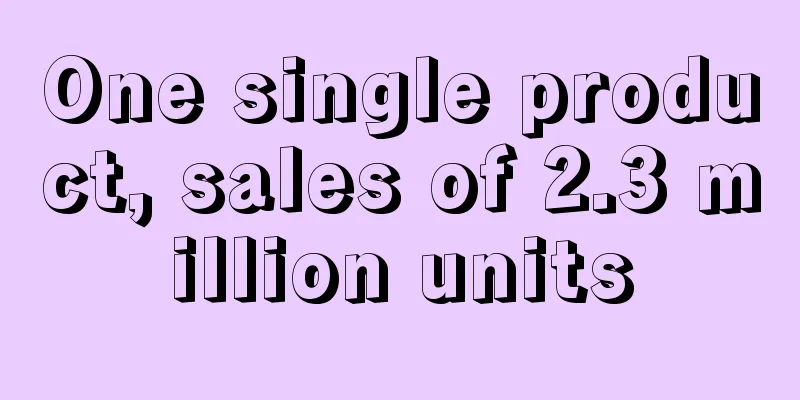From "grass-growing power" to "appealing power", brands need to become "issue suppliers"

Recently, many clients have talked to me about the same topic: planting grass is not as effective as before. In the past, as long as the content was spread to a certain level on some grass platform, there would always be a few "explosive articles" that would bring visible GMV to the cat store. But the current situation is:
The pursuit of commercialization by the grass-growing platforms and MCNs has led to a continuous overdraft of the effect of grass-growing. Most grass-growing has become "product placement in content" rather than "product recommendation with sales power." At the same time, I have seen another phenomenon: some brands are rarely promoted, but they become hot-selling once they are launched on the market. In June, my circle of friends was flooded with screenshots of Li Xiang’s Weibo post, in which Li Xiang talked about the core driving force of Ideal Auto. This year, Li Xiang and Ideal L9 also dominated social media screens. It is said that the car received more than 30,000 orders within 72 hours of its launch, and even became a hot search on Weibo. No one doubts that this achievement is due to Ideal Auto's high advertising budget. Ideal has always been called a "stingy company" by the outside world, with advertising accounting for only 3%. Moreover, car sales are greatly influenced by word of mouth, so car manufacturers are very concerned about maintaining relationships with big Vs, and the budget for seeding and PR is generally very sufficient. However, Ideal Auto usually invites people to test drive and only gives out a small cookie, without even the basic "travel expenses". Dissecting Ideal Auto's marketing strategy, I think this type of brand is not about building brand appeal, but focusing on building brand appeal. I call this type of brand that can set off a hot sales wave as soon as it is launched a "appeal brand." 1. Why does the grass become more bald the more you plant it?The reason why grass-planting is effective is that it reduces "user costs", including learning costs, trust costs, money costs, and reach costs. 1. Learning costsWhen KOLs help promote a brand, the notes and videos they produce become the product’s instruction manual and usage guide. Moreover, KOL’s statements are more popular and easier to understand, which greatly reduces the user’s learning cost. 2. Trust CostWhen KOLs help promote brands, they are essentially using their personalities as a guarantee to lend credibility to the brands. Because fans love the blogger, they believe in what the blogger recommends, which reduces the cost for the brand to gain the trust of consumers. 3. Monetary costThere is a price for brands to pay for looking for KOLs to promote their products, and the price is that the brands must give certain discounts, especially to top bloggers. Because things like planting grass will more or less consume the KOL's trust, the act of planting grass must be covered with the cloak of "pampering fans" so that KOLs dare to make money boldly. When the KOL "buys the price down" from the brand, he is in disguise helping his fans save money. 4. Reach CostIn today's world where advertisements are everywhere, we have learned to automatically ignore and brush away advertisements. The grass-planting material is a "content implantation". KOLs make advertisements into content to attract users to read and lower their defensive psychology. Therefore, grass-planting reduces the cost of enterprises to reach users. To sum it up in one sentence: Grass-planting marketing is essentially about reducing the user's selection cost. But why is the effect of grass-roots promotion overdrawn in the later stage? Because when grass-roots promotion becomes a norm, the user's "vertical cost" is reduced, but the "horizontal cost" does not change. When the promotion is rampant and all competitors are promoting the same thing, the few costs that have already been reduced will be taken for granted by users. 1. Learning cost. Each company has its own strategy, which confuses consumers. 2. Trust cost. Paying money means endorsing, which leads to overdrawn trust. 3. Financial cost. All companies are making concessions, and the prices are no longer attractive. 4. Reach cost. Seeing through the blogger’s routine, the content becomes less attractive and the completion rate drops. However, when a brand focuses on improving the conversion rate of product recommendations and constantly tries to reduce the user's selection cost, it is likely to lead the brand astray. 2. The power of planting grass vs. the power of appealSun protection clothing has suddenly become popular in the past two years. The price of a well-known Taobao brand is about 199 yuan, but the skin clothing of top outdoor brands, such as Arc'teryx, which has been very popular in the past two years, costs about 2,000 yuan. You will see a strange phenomenon: On the one hand, they are noisily soliciting customers. Some Taobao brands that started out as sun protection clothing have been creating a "feeling of extremely low selection cost" to quickly convert users; On the one hand, they are posing coolly. Outdoor luxury brands like Arc'teryx have always exuded charm coolly, making users grit their teeth and spend money. In fact, the technology of sun-proof clothing is not complicated. It uses UV-proof coating or UV-resistant fiber to absorb and reflect ultraviolet rays. Therefore, the sun protection ability of a 2,000 yuan Arc'teryx sun-protective clothing may not necessarily be 10 times stronger than that of a 199 yuan brand, but Arc'teryx has the appeal that the "199" brands do not have. All brands with appeal are essentially not selling products, but selling meaning. In today's era, ordinary people rely on consumption to "invent" their identities. When a person buys Zhang Lei's "Value", it does not mean that he wants to read the book, but it may mean that he hopes to be a "long-termist". He may not have read a single page of the book, but when he buys the book, he possesses the meaning of the book. Contemporary consumers are actually voting with their money, entrusting their spiritual world to a certain "meaning leader" for guidance. Therefore, a true brand will not lead users into a trade-off between interests, but into a trade-off between values. There is no good or bad value, only right or wrong. So I think that brands that focus on the power of seeding and brands that focus on the power of appeal have fundamentally different ways of looking at the world. For brands that focus on the power of promoting customer satisfaction, their way of thinking is to create the "optimal solution", strive to make themselves the best, and will unconsciously please consumers. For example, many new consumer products have white-label prices and feel like big-brand products, so you don’t feel bad about buying them and you don’t feel ashamed to use them. For example, a candy brand might intentionally design its packaging to be larger and reduce the size of individual candies to increase the overall number of candies. The anchor in the live broadcast room can compare the box with the face plate, and then pour the candies on the table and pile them into a small mountain, so that users can feel how cost-effective the 19.9 gift box is. As for brands that focus on appeal, their way of thinking is to create “I aspire to”, strive to be the most correct, and find ways to have the right to speak. Brands that focus on the power of promoting products have been trying to provide consumers with the best value for money, so they have been cultivating "smart consumers." Brands that focus on appeal do not believe that there is an optimal solution in the world. Things in the world are only suitable or unsuitable, so they have been creating a sense of yearning and cultivating "crazy consumers." Such consumers not only do not get a bargain, they also have to make contributions to the brand. This is not difficult to understand, because people will not cherish things that can be easily obtained, including rankings, missions, and products. If you want to become a brand that consumers are willing to pursue and devote themselves to, you must learn to guide consumers' value orientation, turn consumers into brand believers, and become a brand with appeal. 3. Building a “brand with appeal”: from occupying media resources to occupying the right to speak in public opinionIn June, Li Xiang posted about 60 Weibo posts, an average of 2 per day, and a maximum of 9 in one day. Moreover, Li Xiang’s Weibo is not like that of other company founders, which just repost official Weibo advertisements. Most of his Weibo posts discuss social issues. He commented on the subsidy plan for new energy vehicles, criticized Kai-Fu Lee's statement that "buying a car is the worst investment in life", and responded to his peers who said "extended-range electric vehicles are a backward technology"... These remarks, which made the company's PR department tremble, ignited the brand potential of Ideal Auto. We can say that Ideal Auto has a small advertising budget, but we cannot say that Ideal Auto has a small voice in public opinion. Ideal Auto, which has a low advertising budget, actually relies on the founder's Weibo comments to seize the right to speak in public opinion. Tesla is similar to Ideal Auto. In recent years, almost every statement made by Tesla founder Musk has dominated the headlines of financial news or social news. When we see his news, we will actively click on it and, driven by curiosity, actively search for relevant information. Musk's remarks and the information we actively search for around his remarks together constitute our understanding of Tesla and Musk. It can be said that every statement made by Musk is a social issue, and he is trying to seize the right to speak in the world of public opinion. Perhaps because of Li Xiang and Musk's leadership, the bosses of car companies have sensed the importance of seizing public opinion. On June 13, more than a dozen senior executives from Great Wall Motors' brand, technology, supply chain, and finance departments joined Weibo and announced that they would "operate online" there. Obviously, the ideas of Li Xiang, Musk and Great Wall in building brands are completely different from traditional brands. The traditional method is to occupy media resources and block consumers' attention. However, Musk and Li Xiang's method is to create topics, gain control of public opinion, and then attract active attention from society. The difference between the two is that when consumers acquire brand recognition through the occupation of media resources, they have a passive memory, while when consumers acquire brand recognition through the control of public opinion, they actively learn about it and piece together a brand portrait in the process of active search. If the consumer's mind is likened to a pond, then occupying media resources is equivalent to constantly building walls around the pond. The higher and stronger the wall, the purer the consumer's belief. The practice of creating topics and gaining control of public opinion is to continuously heat up the pond, eventually making the water in the pond boil and generating tremendous energy. A brand as appealing as Tesla is essentially an "issue supplier" rather than an advertising maker. If we have to establish a formula for building a brand with appeal, this formula is: Appealing brand = issue supplier × social media amplifier "Social media amplifier" means that brands must learn how to use social media to amplify the potential of an issue. For example, Musk uses Twitter for marketing, and Li Xiang is nicknamed the "King of Weibo" by his opponents. The method of becoming an "agenda supplier" can be divided into three parts: agenda setting, agenda participation and agenda grafting. 1. Topic setting: Setting brand themes and turning “self-narrative” into “public narrative”Why did Li Xiang's long Weibo post about the driving force of Ideal Auto go viral? Because the topic he talked about was "growth." Each of us will encounter growth, big or small, in our life. Growth is the theme of everyone's life. Growth is inevitably accompanied by pain, reflection, and transformation, and it is most likely to resonate with people. As the boss of two listed companies, Li Xiang can be said to be using his own story to talk about things that everyone cares about. When the public feels that this matter is related to them, they will spontaneously pay attention to and discuss it. In the past, we believed that the highest level of a brand was to make the brand equivalent to the category. For example, Coca-Cola represents the cola category, and Xiaotiancai represents the children's watch category. But I increasingly feel that making a brand equivalent to a category is only the result of a brand becoming bigger, and cannot be a method of making a brand bigger. Because the attempt to make the brand equal to the category, the key logic is to block competing products and monopolize the market. This kind of victory depends not only on how strong the brand itself is, but also on how stupid the opponent is, and there is too much uncertainty. More importantly, equating brands with categories is still just brands talking to themselves, forcing their own theories on consumers. In this decentralized era, brands rely on purchasing public resources to speak for themselves, which is not only costly but also inefficient. A more clever approach is to make brand issues equal to public issues, and to arouse the public's collective nerves by talking about public issues. Use a lower budget to create a greater impact. Simply put, brands need to transition from "self-narrative" to "public narrative". To complete this transition, the brand must first be given a theme that is relevant to the public. In the past three years, Lei Jun has delivered three speeches:
The theme of each speech seems to be different, but the content is all about struggle and self-improvement.
Due to the general environment, people's mentality has been turbulent and uneasy in the past few years. Lei Jun used the theme of "struggle" to connect the Xiaomi brand narrative and convey the belief of "keep going" to the public, successfully transforming a story related only to the brand into a social issue related to everyone. To put it bluntly, Lei Jun's speech was held to launch Xiaomi's new products, but they called it an "annual speech" rather than a "press conference." Because the press conference is only the brand's own business, calling it the "annual speech" will make people feel that it is related to them. Therefore, Xiaomi's annual speech can always be on the hot search on Weibo. For emerging brands and new products, if you want to quickly expand your market influence, you can’t just talk to yourself, but you have to integrate your information into things that everyone cares about, so that users will care about you because they care about these things. Tesla talked about the relationship between new energy and "human destiny", which made many people realize the significance of electric cars; OATLY oat milk did not compete with milk in protein content, but dressed itself up as an environmental fighter. These are all setting brand themes and turning "self-narrative" into "public narrative". 2. Participation in the topic: Express your position and gather like-minded people in the discussion of social issuesOn the same day that Shanghai announced that "Shanghai is back", Dibaoer launched the Weibo topic #Dibaoer Respects Shanghai# and created 200,000 "Shanghai is back" commemorative cups, which were given away free of charge to every Shanghai citizen. Although it seems that Diboer is just doing a promotion, it is actually "standing up" for social issues and releasing everyone's inner depression through a ritualistic behavior. The older generation of Chinese entrepreneurs like to keep a low profile and make money quietly. They believe that it is dangerous for businessmen to participate in social issues. Their way of participating in issues is: speak without taking a stance, and take action without expressing an opinion. But the new generation of entrepreneurs seems to be different. You will find that they like to share their thoughts on business and even their reflections on the value of life. They want to popularize not only products and services, but also ideas and values. The more representative entrepreneurs here include: Zhang Yiming, Wang Xing, Fu Sheng, Huang Zheng, Zhou Hongyi, Tang Binsen, and Li Xiang. Today, business has become a public issue in society rather than a private business. Entrepreneurs and start-ups have never enjoyed the same star-like treatment as they do today. When all companies are pushed into the spotlight, it is not a smart move to hide in the shadows and seek safety, because the public not only wants companies to enter the Fortune 500, but also hopes that companies and entrepreneurs will take more social responsibilities. Therefore, future brands can no longer be bystanders of the times, but must learn to resonate with the times. During an accidental interaction on the topic of childbirth, Babycare received complaints from 620 mothers about the pain of childbirth and their gratitude for being painless.
Because of this opportunity, they conducted a survey and found that only 30% of people in my country use painless childbirth. The remaining 70% of mothers suffer from the pain of childbirth due to various reasons such as concepts and funds. Therefore, Babycare launched a campaign on Weibo called "Mother's love does not need pain to prove" and joined forces with 13 brands including PROYA, Watsons, and Cetaphil to speak out for women's childbirth pain. Later, the topic #Only 30% of mothers in my country use painless childbirth# became the number one hot search on Weibo. This is not the first time that Babycare has spoken out on the issue of "female fertility". On Brand Day in 2021, they posted a poster of stretch marks on a pregnant belly, but received a notification that the "platform review failed." So they posted a tweet saying "If you don't understand, just ask. Why are stretch marks marked 404?", which sparked widespread discussion. These things Babycare does obviously have no direct relationship with the brand's business, so why does it have to do it? Because brands can express their stance on social issues and gather people with similar values. The more people see you taking the initiative to take social responsibility, the more people will choose to stand with you, and you will have greater appeal. Let’s take a look at the international brand Coca-Cola. Coca-Cola has always been concerned about global social issues. They found that Peru has a low happiness index, so they put 30 miniature cameras in the country, which can quickly help people take ID photos. However, the camera will only start when it captures people's mouth corners raised. Coca-Cola has done a lot of similar things. For example, the wrapping paper was turned into a 5kg luggage check-in label so that people away from home can bring gifts home for their families; a telephone booth was designed where you can make an international long-distance call and talk to your family for three minutes by inserting a Coca-Cola bottle cap... To be a brand with appeal, you can’t just attract users by promoting your products. Instead, you must dare to speak out for social issues and become a “beacon” to attract people of the same kind to approach you. 3. Issue grafting: from betting on resources to betting on issuesDouble 11 has evolved from a shopping event into a cultural phenomenon. Last year on Double 11, because Tmall’s Double 11 pre-sale and official sales time was changed from 0:00 to 8:00 in the evening, some netizens began to call themselves “the last 8 people”. Tmall then initiated an interactive topic about “the last 8 people” on Weibo. They also found that using "1" to represent "received" at work has become a social culture among workers, so they combined this phenomenon with "Double 11" and launched a campaign #Lifemustbe1111. By separating social issues from cultural phenomena, Tmall does not just occupy resources, but uses issues to attract users and truly "move" traffic. We often equate traffic with resources, and think that the way to obtain traffic is to purchase good advertising resources, such as buying the World Cup title sponsorship or pre-roll ads. But in fact, traffic and traffic value are different. For example, on Weibo, the same copywriting is called #肖敬腾求婚#, and the other copywriting is called #肖敬腾求婚好多地方下雨#. The click-through rates of these two hot search copywritings are different. Therefore, traffic must be attached to content value in order for traffic to generate conversions. Social issues are often the best content because they can become bigger issues in the process of public opinion. At the 2021 European Cup, when Cristiano Ronaldo was interviewed by the media, he moved two bottles of Coca-Cola out of the camera with disgust, picked up mineral water and shook it at the camera, saying that he only drank "healthy drinks." Ronaldo's refusal to appear in the same frame with Coca-Cola was a typical public relations crisis. However, Coca-Cola took advantage of the situation and launched a campaign of "buy a family pack of Coca-Cola and get a bottle of mineral water for free". Coca-Cola not only turned the crisis into sales, but also reversed its reputation. When Portugal won the game, netizens even started toasting Ronaldo with Coke. The clever thing about Coca-Cola is that they not only focus on the traffic brought by advertising resources, but also make good use of social issues. The traffic brought by advertising resources is open to the public, you can buy it, and your competitors can also buy it. We cannot rely on this method to gain a competitive advantage. The traffic generated by the topics is hidden in the dark. The key lies in whether the brand has the vision to discover those topics and use resources reasonably to amplify the power of the topics. Purchasing resources only brings limited traffic. However, grafting an issue onto a brand allows traffic to grow, which brings “unlimited” traffic. Final Words"Chasing after consumers to please them" and "making consumers follow them" are two completely different brand management ideas. If you just pursue the conversion rate of planting grass, the brand will be exhausted sooner or later. But if you make consumers believers in the brand, they will actively follow you and even push you forward. Those companies that become agenda suppliers, dare to represent the values of the times, and dare to speak out for the issues of the times will eventually be rewarded by the times. Author: Liang Jiangjun, public account: Liang Jiangjun (ID-liangjiangjunisme) |
<<: What? The Yogurt Assassin is here too!
Recommend
Can a self-employed person register on Amazon? Can a self-employed person enter Amazon?
Many merchants who open stores on Amazon hire a co...
13 Xiaohongshu matrix accounts generated over 40 million sales. Here is the traffic code behind the matrix sales notes!
This article analyzes the business of selling prod...
How much does the TradeKey platform cost? Is TradeKey free?
TradeKey is the largest B2B platform in the Middle...
Can I apply again if I am rejected by Meikeduo? How can I strengthen my account security?
If you are doing e-commerce, you can generally cho...
Douyin food account sales 100,000+, master these 8 skills
Introduction: This article mainly briefly describe...
How does Amazon set up the pre-sale model? What are the pre-sale rules?
With the rapid development of the e-commerce indus...
Where can I view Amazon's deduction details? How can I cancel Amazon's automatic deductions?
When we open a store on Amazon, if we want to unde...
Is there a promising future for the toy business?
Will the toy business be a promising field in the ...
Talk about unemployment! 6 steps to quickly screen Xiaohongshu bloggers suitable for brand placement!
This article analyzes the experience and evaluatio...
How to upload the EPR registration number of Alibaba International Station? What is the method?
There are many merchants opening stores on Alibaba...
Is it necessary to have an Amazon agent to register? What are the requirements for registration?
Many people want to engage in cross-border e-comme...
Shopee announces its Double 11 promotion advertising strategy
Shopee announced the advertising methods for the D...
With the European Cup approaching, can Chinese overseas brands still reap the benefits?
Chinese brands are gradually going abroad and work...
E-commerce platform advertising war: Shake ads provoke Apple to fight back
As the Double Eleven shopping spree came to an end...
How to print Shopee logo card? How to operate?
Speaking of Shopee e-commerce platform, I believe ...









